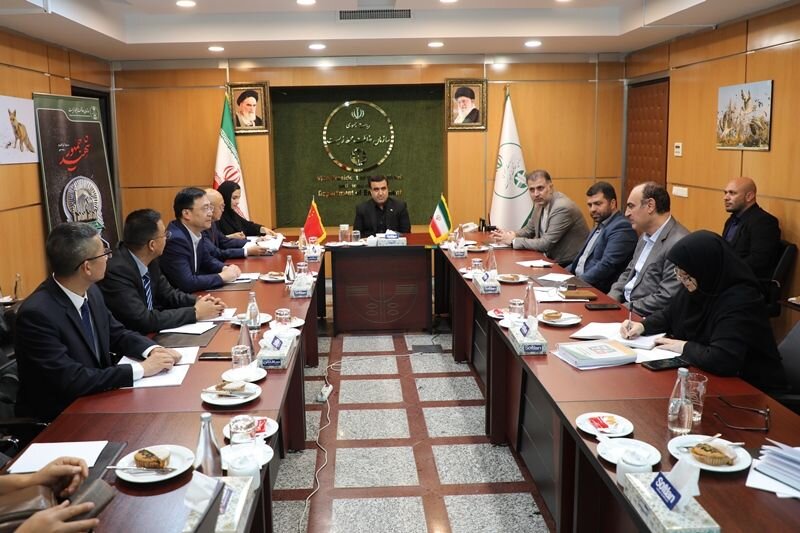Tehran, Beijing explore paths to enhance environmental co-op

TEHRAN –A delegation headed by Wan Gang, the Chinese Minister of Science and Technology, met in Tehran on Monday with Ali Salajeqeh, the head of the Department of Environment, to foster collaboration under the 25-year cooperation agreement which was signed by the two countries in March 2021.
During the meeting, the two sides announced readiness to implement joint environmental projects that aim to combat sand and dust storms, desertification, air pollution, as well as climate change, the DOE website reported.
Other issues will involve waste management, wildlife protection, and sea-oriented development.
"Climate change is one of the major issues that concerns the whole world, Iran and China can address this global challenge through joint cooperation," DOE website quoted Salajeqeh as saying.
“Sand and dust storms severely affect countries in the Middle East, particularly West Asia. China is also quite familiar with this phenomenon,” the official stated.
"Fortunately, in the last three years, we have managed to establish a regional and international convergence in which China has also actively participated. Moreover, the resolution proposed by Iran on dealing with sand and dust storms was adopted by consensus in the United Nations, and July 12 has been recognized globally as the 'International Day of Combating Sand and Dust Storms'. The resolution requires all countries to take effective measures to promote international cooperation to combat sand and dust storms," Salajeqeh further noted.
Referring to the issue of sea-oriented development as another part of cooperation, he said according to the principles of sustainable development, sea-oriented development is on the agenda of Iran.
Sea-oriented development encompasses a wide range of activities including the sustainable use of marine resources, the expansion of transportation lines and shipping capacities, the development of maritime trade, and the establishment of industries on the coasts of the seas and other activities.
DOE intends to preserve the marine ecosystems and habitats of the country in accordance with the environmental rules and enhance development on the northern and southern coasts of the country.
In the end, the official went on to say that Iran is willing to cooperate with China to address other environmental hazards such as wetlands restoration, noise pollution, unpleasant odors, landslides, drought, forest fires, and other issues.
He expressed optimism that the two countries would be able to enhance cooperation in all the above-mentioned environmental sectors, in both the research and implementation fields.
Measures to mitigate climate change
Currently, drought and desertification, as a part of a prevalent phenomenon called climate change, are imposed on the world, including our country, Salajeqeh noted.
He made the remarks on the occasion of World Day to Combat Desertification and Drought, which is annually observed on June 17.
The official went on to say that human impacts on climate change are limited, however, the way they treat the environment can intensify and hasten the changes.
Stressing that climate change has occurred in different geological periods, Salajeqeh stated, “Currently, the earth is undergoing the consequences of climate change, the two results of which are low precipitation which has resulted in drought; and increasing temperature that has changed seasonal patterns.
To moderate the impacts of climate change, human lifestyle from home activities to large-scale management needs to consider the current conditions like reduced water resources, raised temperature, extreme or lack of precipitation, and snowfall.
There are several ways to achieve this goal at all levels including policymaking, the presentation of the program, and its implementation.
Water-intensive crops should not be cultivated; clean fuels should be used. Underground water sources should be consumed in such a way that erosion is minimized, and restoration of nature is maximized.
Water and soil resources and fossil fuels should not be used as in normal conditions, there should be a shift from fossil fuels to renewable energies.
This way, threats can be turned into opportunities and a non-wasteful lifestyle will be promoted.
Considering the role of SDSs in aggravating land degradation, the DOE has taken measures at both national and international levels to deal with SDSs.
Sand and dust storms are one of the factors contributing to land destruction and accelerating desertification, as well as other environmental issues such as harm to people's health, well-being, and livelihood; deforestation; loss of land productivity; and decline in biodiversity.
The DOE has so far held a regional conference with the participation of 11 regional countries and a number of international organizations; as well as an international conference with the participation of about 50 countries and 15 international institutions.
Both conferences featured good statements on the establishment of a regional center and a fund to support collaborative efforts at regional and international levels, the implementation of two sub-regional action plans for the west, southwest, east, and northeast of the country.
Moreover, the 6th United Nations Environment Assembly (UNEA-6) approved a resolution adopted at the international summit on dealing with sand and dust storms which was held in Tehran in September 2023.
Enhancing collaborations among different organizations to manage dust storms produced by internal dust zones effectively; holding bilateral and multilateral meetings with the officials of Syria, Iraq, Saudi Arabia, Turkmenistan, Qatar, and Kuwait, and implementing the agreements concluded with these countries to address the SDSs are among taken actions by the DOE.
MT/MG
Leave a Comment